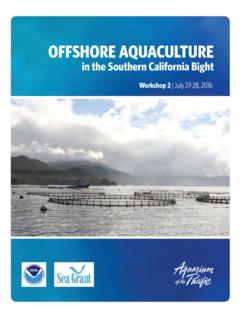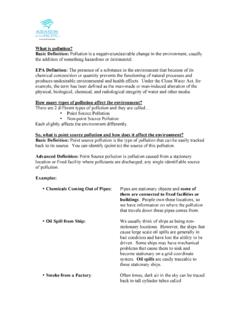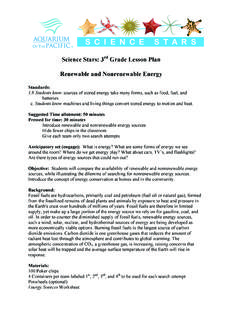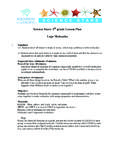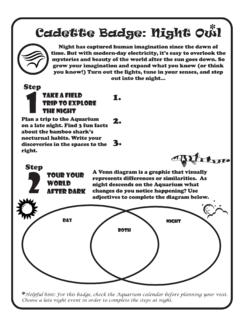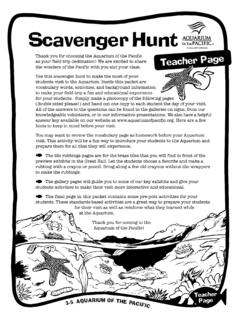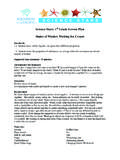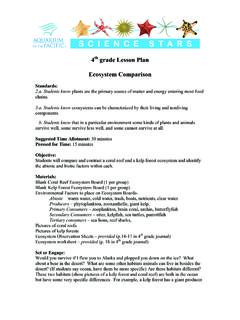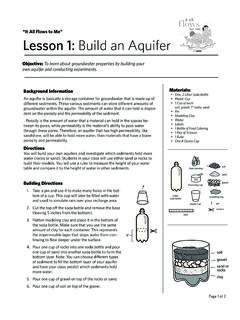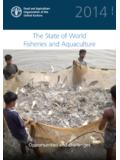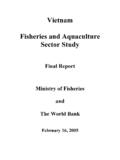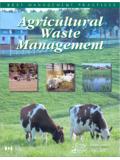Transcription of OffshOre AquAculture - Aquarium of the Pacific
1 OffshOre AquAculture in the southern california Bight April 28-29, 20153 AquAculture WORKSHOP RePORTThis summarizes the major findings and recommendations of an AquAculture workshop held on April 28-29, 2015 at the Aquarium of the Pacific . A list of participants and observers is located in Appendix 1. The meeting agenda, com-prehensive minutes of the meeting, and copies of the slides used in the presen-tations and the report can be found at: OffshOre AquAculture in the Southern California BightImage courtesy of Blue Ocean Mariculture4 AquAculture WORKSHOP RePORT5 AquAculture WORKSHOP RePORTThe workshop and proceedings are a result of work sponsored by the California Sea Grant College Program, Project R/Q-136, under Award NA140AR4170075 from National Sea Grant, NOAA, Department of Commerce, with funds from the State of workshop organizers would like to thank the many people who have contributed time, expertise, and advice to this project.
2 The workshop would not have been pos-sible without the dedicated efforts of all the participants. In particular, we are grateful to Linda Brown for orchestrating the workshop and preparation of workshop materials. We give special thanks to Molina Health Care for making their Event Space available for the meeting at no cost. Thanks to our rappor-teurs, Annalisa Batanides, Rachel Fuhrman and Jonathan MacKay. We also thank Chris Hernandez, Derek Balsillie, and Victor Vallejo for AV support and Lisa Wagner for her advice on the development and distri-bution of the on-line workshop survey. We acknowledge with gratitude Rich Wilson, Seatone Consulting for his superb facilitation of the workshop. We would also like to thank Randy Lovell, state AquAculture coordinator with the California Department of Fish and Wildlife for his thoughtful comments on the drafting of this WORKSHOP RePORTJ ames MorrisPaul OlinKenneth RileyJerry SchubelKim ThompsonDiane WindhamThe Steering CommitteeBack row from Left to right: Annalisa Batanides, Penny Ruvelas, Kim Thompson, Carol Price, Randy Lovell, Dale Kiefer, Russ Vetter, Don Kent, James Morris, Bryant Chesney, Walt Wilson, Letise LaFeir, Thomas Dempsey, Kevin Amos, Paul Olin, Mark Drawbridge, Michael Rust, Michael L.
3 Van Houten, Linda Row from left to right: Sandra Oh, Dave Caron, Rich Wilson, Amy Rens, Bonnie Rogers, Dan Swenson, Melanie Tymes, Rachel Fuhrman, Jerry Schubel, Diane Windham, Jonathan McKay, Ken Riley, Paula WORKSHOP RePORTT able of ContentsAcknowledgements ..5 The Steering Committee ..6 Introduction ..9 The Need and the Opportunity for the U .S . and California to Take Leadership Roles in OffshOre AquAculture .. Marine AquAculture ?..12 Why domestic production in the United States? ..13 Why California?..14 Issues and Concerns Associated with Marine Findings ..17 Issues of of the Science ..18 Public Perceptions of OffshOre AquAculture ..18 The Precautionary and Challenges in State versus Federal Waters ..19On Monitoring OffshOre Finfish AquAculture Operations ..20On The Importance of a Scale: From Demonstration to Mature Ad-Hoc Inter-Agency Working Group ..22 Identifying Research Needs and Data Sharing Platforms.
4 23 Summary of Recommendations ..24 References ..25 Appendix 1 ..26 Participants and 2 ..28 Rose Canyon Fisheries Project Description ..28 Executive Summary ..288 AquAculture WORKSHOP RePORT9 AquAculture WORKSHOP RePORTThe Sea Grant Workshop on OffshOre AquAculture in the Southern California Bight ( Aquarium of the Pacific , Long Beach, California, April 28-29, 2015) was convened to develop the frames of reference and rationale for cre-ation of an OffshOre finfish aquacul-ture industry in southern California. The workshop was attended by 44 people that represented a cross-section of scientists, regulators, and industry practitioners with proven expertise in the field of AquAculture and environmental science. All state and federal agencies with regulatory responsibili-ties for permitting AquAculture were invited to participate and each agency was generally well represented. Workshop participants were asked to share and prioritize concerns regard-ing the complex, high-stakes environmental and resource issues often associated with coastal development activities.
5 A professional facilitator guided conversations and consen-sus building activities, especially when tough policy questions combined lively politics and contested facts. While permitting remains an uncertain, uncoordinated, unstable, and inconsistent process for OffshOre farms in California, all workshop participants were re-quested to work together to formulate specific recommendations to improve the process for reviewing permits and obtaining approvals for AquAculture development inspecting sea cage. Image courtesy of NOAA Fisheries10 AquAculture WORKSHOP RePORTW hile it was not the intention of the work-shop, the Rose Canyon Fisheries1 project became a focal point for much of the workshop discussion since its permit applica-tion is currently under review. Rose Canyon Fisheries proposes to establish the first finfish farming operation in federal waters. The farm will be sited miles ( km) from the San Diego coastline.
6 The commercial dem-onstration project represents a partnership between Hubbs SeaWorld Research Institute and Cuna del Mar, a private equity fund for marine AquAculture development. The pro-posed project will produce 5,000 metric tons of yellowtail jack, white seabass, and striped bass in sea cages with harvested product landed along traditional working waterfronts in the region. The review and discussion on the Rose Canyon Project provided a basis for a greater discussion on the risks and rewards for OffshOre AquAculture development in the region. Goal of the WorkshopAs stated in the workshop agenda: The goal of the workshop is to develop the frames of reference and rationale for creation of an OffshOre finfish aquacul-ture industry in the Southern California Bight. OffshOre AquAculture development has been a subject of intense debate in coastal communities around the nation. Large barriers to starting new OffshOre AquAculture ventures are public percep-tion and regulatory concern that industry development will have significant environmental impact.
7 A critical element needed by coastal managers and stake-holders is awareness and confidence to use science-based decision tools to inform coastal ocean use plans and equitably resolve points of resistance to industry development. 1 A complete project description is provided in Appendix 211 AquAculture WORKSHOP RePORTThe Need and the Opportunity for the U .S . and California to Take Leadership Roles in OffshOre AquacultureIntroductionThe production and consumption of energy and protein-rich food by humans have the greatest impact on natural resources glob-ally. Increasing wealth and urbanization throughout the world drive the demand for more energy and food, creating increasing pressure on the planet s finite resources. With the world population expected to exceed 9 billion by 2050, the Food and Agricul-ture Organization (FAO) estimates that food production will have to increase by 70 per-cent to meet the growing demand, and needs to accomplish this while adapting to climate change and combating global hunger and poverty (FAO 2011).
8 A promising opportu-nity to meet these challenges internationally and domestically is to invest in people and provide resources to expand the availability of protein sources through production of seafood. Seafood is a healthy protein source that has great potential to help meet the burgeoning need for protein rich foods while minimally impacting the environment. Seafood is the primary source of protein for more than 3 billion people on the planet and is widely recognized as contributing to a healthy diet. A desire for seafood, coupled with growing and more affluent global populations mentioned above, has created a Source: FAO (2012) State of the World Fisheries and AquAculture 12 AquAculture WORKSHOP RePORT dramatic increase in seafood demand. Wild-capture fishery harvests have remained essen-tially flat since the late 1980 s and have been unable to satisfy growing demand. Since then, seafood consumption has roughly doubled and this was made possible in part through increasing production of farmed fish, shellfish, and aquatic plants.
9 As it has for the past 25 years, AquAculture will play a substantial role of meeting society s need for increasing food supplies into the future. It is no surprise that AquAculture is the fastest-growing food production sector in the world and the FAO estimates that an additional 27 million metric tons (mmt) of farmed seafood products will be needed to meet projected demands by 2030. Farmed seafood accounts for more than half of our seafood supply and pro-duction of farmed seafood by weight recently surpassed that of AquAculture offers many environmen-tal benefits, and relative to other forms of animal protein production, marine aquacul-ture is an attractive option for expanding production. AquAculture operations in the marine environment typically generate fewer greenhouse gas emissions, have a smaller car-bon footprint, use less land and fresh water, and are very efficient at converting feed into edible protein (Welch et.)
10 Al. 2010; Torrissen et. al. 2011; and Troell et. al. 2014). Aquacul-ture also has the potential to reduce pressure on wild fisheries while also increasing the availability of safe, secure, seafood products. Why Marine AquAculture ?To feed the current global population of billion people, 75 percent of developed land is used for terrestrial agriculture production, including livestock, that consumes 70 per-cent of all freshwater resources. Despite this, more than 800 million people are chronically undernourished. The ocean covers more than 70 percent of the Earth s surface yet capture fisheries and a small marine AquAculture sec-tor produce only 2 percent of the global food supply. One way to meet growing seafood demand while minimally impacting the environment is to expand marine aquacul-ture. Well-designed and well-managed marine AquAculture farms utilizing best management practices can provide seafood to improve human health and create economic develop-ment without unacceptable environmental majority of the world s AquAculture production occurs in freshwater systems.
